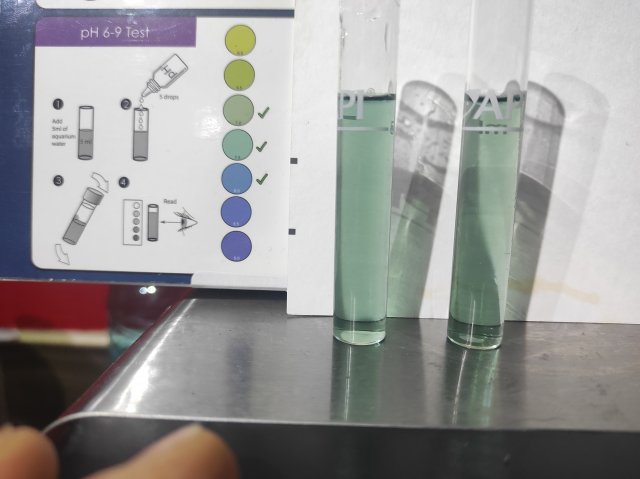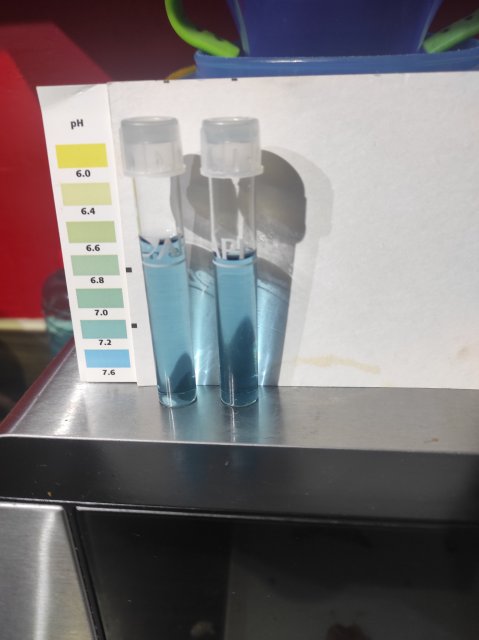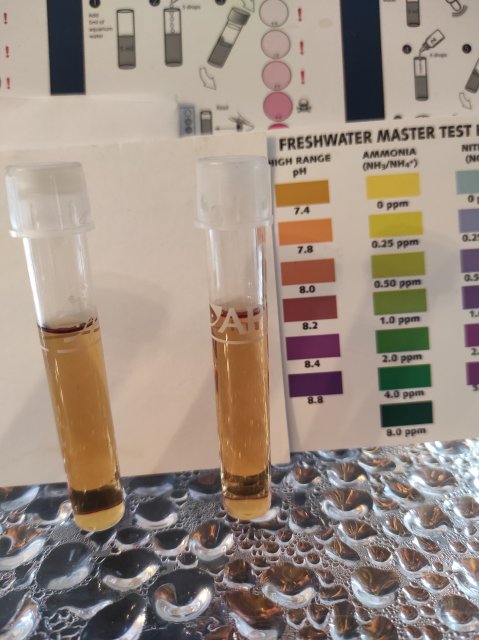Meeki and certain swordtails came from Yukaton peninsular of Mexico, which is a limestone formation where the water is hard and alkaline, the opposite of black water. Most fish in CA are hard water species, as opposed to mostly soft water fish in Amazon basin. So softening the water will hurt, not help CA species.
Central America black water
- Thread starter Tripping Willow 91
- Start date
You are using an out of date browser. It may not display this or other websites correctly.
You should upgrade or use an alternative browser.
You should upgrade or use an alternative browser.
Thanks Rocksor
Does anyone know if the tint from tannins last longer in soft water compared to hard, have there been any studies conducted to see if hard water actually buffers out the visual tint provided by tannins?
This would explain where the tint in my water has gone/is going, it's getting trapped in the canister media.So my guess is that some of the tint from peat is particulate matter
Does anyone know if the tint from tannins last longer in soft water compared to hard, have there been any studies conducted to see if hard water actually buffers out the visual tint provided by tannins?
I maintain a single large dry leaf of Magnolia grandiflora, in each of my tanks. All tanks are planted. It does not affect pH and anything, but it first floats, then sinks, then decomposes slowly. I find that my bushynose plecos and cories love to hide and eat it, and other fish peck at them. I replace each leaf after about 3weeks to a month. It cannot harm anything, and instead my fish and I Iike them, and I have a big tree in my backyard.
In looking at those before and after pictures, I don't think there is much difference in the actual colour of the water, just the clarity. Those are two different things. You can have quite a dark staining of the water, but the water is still clear, as opposed to cloudy. Your first pic shows that typical cloudiness that a freshly-filled tank usually shows on day one, and which usually disappears within a day or so on its own.
It's like tea in a glass; it can be quite dark if strong, but still completely clear or "non-cloudy". Perhaps a better analogy would be a glass of typical horrible commercial beer versus a glass of quality home-made or craft-made beer. Both can be the exact same colour, but the commercial stuff will be crystal clear whereas the handmade product will usually have some suspended sediment that imparts a cloudiness.
I'm sure that the tannic acid can be buffered out and lost, but I tend to think it would take longer than one day. Did you by any chance measure your pH at the same time as those pics were taken?
I am happy to keep fish that suit my well water, which means no blackwater stuff...which is great because I can't stand the look of blackwater in a tank, even "clear, non-cloudy" blackwater. I just naturally equate the colour of blackwater with a build-up of the kind of waste products that I am constantly changing water to avoid...not accurate, I know, but there it is. I want to enjoy my tanks and I know I won't enjoy them if they look like they are filled with pee.
I also do as F FJB does, by keeping dried leaves in most tanks, in my case oak leaves. They break down quickly, and thanks to water changing they don't produce any noticeable changes in water colour or acidity, but they are greatly appreciated by shrimp and also provide some natural microscopic first foods for newly-hatched fry...and I just like the way they look.
Looking forward to watching this tank progress!
It's like tea in a glass; it can be quite dark if strong, but still completely clear or "non-cloudy". Perhaps a better analogy would be a glass of typical horrible commercial beer versus a glass of quality home-made or craft-made beer. Both can be the exact same colour, but the commercial stuff will be crystal clear whereas the handmade product will usually have some suspended sediment that imparts a cloudiness.
I'm sure that the tannic acid can be buffered out and lost, but I tend to think it would take longer than one day. Did you by any chance measure your pH at the same time as those pics were taken?
I am happy to keep fish that suit my well water, which means no blackwater stuff...which is great because I can't stand the look of blackwater in a tank, even "clear, non-cloudy" blackwater. I just naturally equate the colour of blackwater with a build-up of the kind of waste products that I am constantly changing water to avoid...not accurate, I know, but there it is. I want to enjoy my tanks and I know I won't enjoy them if they look like they are filled with pee.
I also do as F FJB does, by keeping dried leaves in most tanks, in my case oak leaves. They break down quickly, and thanks to water changing they don't produce any noticeable changes in water colour or acidity, but they are greatly appreciated by shrimp and also provide some natural microscopic first foods for newly-hatched fry...and I just like the way they look.
Looking forward to watching this tank progress!
Yes I'm aware meeki and swordtails are from hard alkaline waters, this is the main reason I have chosen these fish, as my water is very hard and alkaline. I'm certainly not trying to lower my pH with tannins, I'm trying as best I can to recreate the waters that these fish naturally inhabit. A lot of the videos/images I have seen our of meeki in waters that are covered in leaf litter and wood so I'm also using these in my aquarium but with wood and botanicals comes tannins. I quite like the tannin effect and my water is so hard I doubt it'll have any affect on my pH, I just wanted to find whether tannin tint was naturally present in meeki water and if not then why not, considering all the leaf litter etc that seem to be presentMeeki and certain swordtails came from Yukaton peninsular of Mexico, which is a limestone formation where the water is hard and alkaline, the opposite of black water. Most fish in CA are hard water species, as opposed to mostly soft water fish in Amazon basin. So softening the water will hurt, not help CA species.
I also like the look botanicals provide, it really helps to make the tank look more natural, which is exactly what I'm after. I plan to keep adding more leaves, cones etc and cover the majority of the substrate, I'm sure the fish will enjoy it and it should encourage natural foraging behaviourI maintain a single large dry leaf of Magnolia grandiflora, in each of my tanks. All tanks are planted. It does not affect pH and anything, but it first floats, then sinks, then decomposes slowly. I find that my bushynose plecos and cories love to hide and eat it, and other fish peck at them. I replace each leaf after about 3weeks to a month. It cannot harm anything, and instead my fish and I Iike them, and I have a big tree in my backyard.
Thanks for explaining it like that, it makes sense to me, especially as a homebrew enthusiast. Basically the water is still coloured it's just the sediment has been filtered out (like commercial brew) or settled (cold crashed homebrew).In looking at those before and after pictures, I don't think there is much difference in the actual colour of the water, just the clarity. Those are two different things. You can have quite a dark staining of the water, but the water is still clear, as opposed to cloudy. Your first pic shows that typical cloudiness that a freshly-filled tank usually shows on day one, and which usually disappears within a day or so on its own.
It's like tea in a glass; it can be quite dark if strong, but still completely clear or "non-cloudy". Perhaps a better analogy would be a glass of typical horrible commercial beer versus a glass of quality home-made or craft-made beer. Both can be the exact same colour, but the commercial stuff will be crystal clear whereas the handmade product will usually have some suspended sediment that imparts a cloudiness.
I'm sure that the tannic acid can be buffered out and lost, but I tend to think it would take longer than one day. Did you by any chance measure your pH at the same time as those pics were taken?
I am happy to keep fish that suit my well water, which means no blackwater stuff...which is great because I can't stand the look of blackwater in a tank, even "clear, non-cloudy" blackwater. I just naturally equate the colour of blackwater with a build-up of the kind of waste products that I am constantly changing water to avoid...not accurate, I know, but there it is. I want to enjoy my tanks and I know I won't enjoy them if they look like they are filled with pee.
I also do as F FJB does, by keeping dried leaves in most tanks, in my case oak leaves. They break down quickly, and thanks to water changing they don't produce any noticeable changes in water colour or acidity, but they are greatly appreciated by shrimp and also provide some natural microscopic first foods for newly-hatched fry...and I just like the way they look.
Looking forward to watching this tank progress!
I never tested the pH after adding the tannins as I was confident that they would have little to no affect on my hard water. I will test my pH this evening when I'm back home.
I love the black water look but if it's not correct for the meeki habitat theme I'm going for then I will keep it minimal. Botanicals are definitely present in their natural waters and I believe they're beneficial so I will still continue to add leaf litter, cones etc but just at a lower/slower rate to avoid a massive tannin tint.
At present this tank actually has 40-80 cherry shrimp in and they're loving the leaf litter, not sure they'll be so happy when the meeki arrive ?.
I have a thread going on this tank if you'd like to see where it started and follow my progress with it. Mostly everything about it is new to me so it's been a lot of learning, before this I was all about high tech heavy planted with tiny community fish
Last edited:
So I checked my pH to see if the tannins had made any difference to it. The tannins/botanicals were added on Tuesday, before adding the tank had a 95%+ wc and I didn't test the pH at this time but my tap is usually 8-8.2 according to my API kit. I last tested my tap on 28/12 and the API came back as pH 8. This evening's results were quite surprising, API high rage 7.4, low range 7.6, I then tested my tap and the results were exactly the same. I've never seen my tap this low but my API is old and probably not reliable, I recently bought an NT kit so I tested both tap and tank with this and both came out at 7.5. The results seem to show what I was expecting, the tannins have not effected my pH (if they did then it's worn off)but it also appears my tap water is softer than usual. I've never been mad keen on testing parameters too often but I think I'll monitor the tap for the next few weeks just to see how stable it actually is.






My SA tanks are pH 7.4, hardness on the moderate side, good bit of driftwood, sometimes also leaves. Considering I typically do about 80% water changes, the water is clear after a water change, then colors up until the next water change. So, there's enough buffering that pH doesn't drop, but the minerals do not neutralize the tannin color-- instead it builds up over time while pH and hardness are unaffected in the week or so between water changes.
In fact, when a newly collected piece of driftwood makes a tank murkier or darker than I want, I add carbon to a filter to attenuate the effect more to a shade I like. For this purpose, depending on factors like how much carbon, it lasts about last six weeks for me in heavy tannins. In other words, carbon (and some other chemical media) absorbs tannins.
Different materials will produce different shades in your tank, darker or lighter, from yellowish to brown to murky brown to blackish. This tells you something about what they're releasing because fulvic acids are more yellow, humic acids more brown. This is why you see different shades of color in tannin tanks. Also, ime hard water fish are not bothered by some tannin color, as long as mineral buffering keeps the chemistry in their range. For example, I like to raise fry with driftwood to graze on and I've raised Cyphotilapia fry in driftwood colored tanks and they did quite well.
In fact, when a newly collected piece of driftwood makes a tank murkier or darker than I want, I add carbon to a filter to attenuate the effect more to a shade I like. For this purpose, depending on factors like how much carbon, it lasts about last six weeks for me in heavy tannins. In other words, carbon (and some other chemical media) absorbs tannins.
Different materials will produce different shades in your tank, darker or lighter, from yellowish to brown to murky brown to blackish. This tells you something about what they're releasing because fulvic acids are more yellow, humic acids more brown. This is why you see different shades of color in tannin tanks. Also, ime hard water fish are not bothered by some tannin color, as long as mineral buffering keeps the chemistry in their range. For example, I like to raise fry with driftwood to graze on and I've raised Cyphotilapia fry in driftwood colored tanks and they did quite well.
Last edited:
So I checked my pH to see if the tannins had made any difference to it. The tannins/botanicals were added on Tuesday, before adding the tank had a 95%+ wc and I didn't test the pH at this time but my tap is usually 8-8.2 according to my API kit. I last tested my tap on 28/12 and the API came back as pH 8. This evening's results were quite surprising, API high rage 7.4, low range 7.6, I then tested my tap and the results were exactly the same. I've never seen my tap this low but my API is old and probably not reliable, I recently bought an NT kit so I tested both tap and tank with this and both came out at 7.5. The results seem to show what I was expecting, the tannins have not effected my pH (if they did then it's worn off)but it also appears my tap water is softer than usual. I've never been mad keen on testing parameters too often but I think I'll monitor the tap for the next few weeks just to see how stable it actually is.
View attachment 1485564
View attachment 1485565
View attachment 1485566
When you tested your tap water PH, was it sitting in a cup for 24 hours before testing it? Also, your water authority could be collecting water from other sources, hence the change in your tap water PH. More rain in the water reservoir could mean less water from some other source.
PH is not a reading of how soft the water is. It's a measurement of acidity/alkalinity.
GH is a reading use to determine how soft the water is.


